By Kim McDarison
The School District of Fort Atkinson Board of Education, after receiving two presentations during its June 16 meeting from the district’s Director of Business Services Jason Demerath, instructed staff to make preparations and return to its July board meeting with a referendum question asking residents to approve funding of $22 million for improvements to the district’s facilities.
The capital improvement referendum amount of $22 million reflects a reduction from the previously considered amount of between $49 and $59 million, which, Demerath said, was the range shared with the public last fall. The decision to reduce the referendum to $22 million was made in response to answers received from the community to questions asked in the district’s surveys. Surveys were conducted last November and last month.
A story about the districts two survey and responses is here: https://fortatkinsononline.com/school-district-survey-shows-community-support-for-funding-elementary-school-maintenance/.
According to information provided in the presentations, the $22 million would be used to fund a portion of the Phase 2 improvements as outlined by the district last fall, pushing a referendum request for funding to build a new middle school to the November 2026 ballot.
In addition, the board gave the nod to developing operational referendums spanning the next several school years, including a four-year recurring referendum of $2.7 million, a $4.4 million non-recurring referendum in the 2023-24 and 2024-25 school years, and a $5.5 million non-recurring referendum in the 2025-26 school year.
Within the presentations, Demerath presented a draft of the 2022-23 school year preliminary budget of $41 million, which showed an anticipated shortfall of just under $1 million, which, he said, “was planned as we will be entering the third year of our (previously approved) operational referendum.”
The number will be offset by what Demerath defined as a “major factor,” which, he said, was “that our referendum-approved debt will be completely paid off next year.”
The result, Demerath said, is that the proposed tax levy of $16 million is $3.5 million less than last year, which, he noted, “will translate into a projected tax rate of $8.72, a 20% decrease from the current year.”
Budget presentation
Aided by slides, Demerath’s first presentation shared a draft of the 2022-23 preliminary budget. The following information was presented.
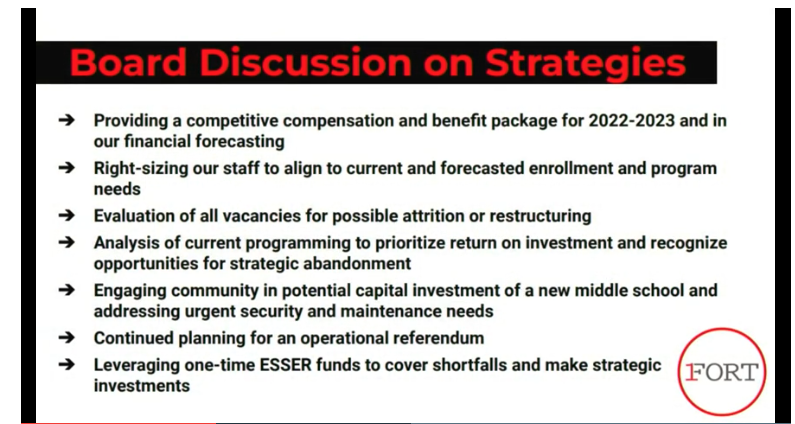
Demerath began his first presentation with a recap of information shared with the board in January and February, revolving around “high inflationary impacts related to compensation and health insurance.”
In an effort to mitigate those impacts, he said, the board approved moving forward with several strategies. He outlined seven strategies as presented on a slide (shown above).
He said the seven strategies had been utilized by the district in its planning processes.

Demerath next talked about the annual budget process, and presented a timeline of activity relating to that process. He said the process continues year-round, adding: “As we are finalizing the current year’s budget in the fall, the Administrative Team is already beginning to meet to discuss the following year’s budget.”
The team meets monthly, he said.
Referencing the timeline (shown above), Demerath said once the current year’s budget is set in late October, a long-range financial projection is presented to the board in December or January. The Administrative Team then presents compensation and other budget recommendations to the board in April.
A first draft of the upcoming year’s budget is presented in June, and a second draft in July, at which time staff seeks board approval. The budget comes before the electorate during the Annual Meeting in August. The annual cycle concludes with approval of a final budget and tax levy by the board in late October, Demerath said.
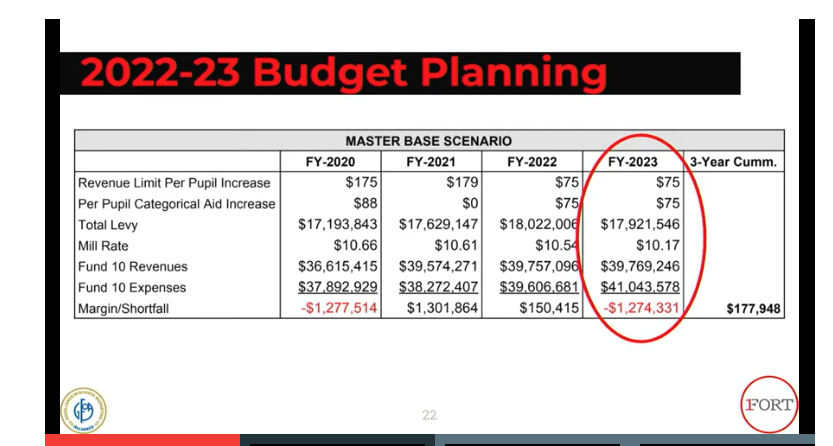
Aided by a slide titled “2022-23 Budget Planning” (shown above), Demerath said the chart was a summary of the projection from the district’s financial planning leading up to the referendum in April, 2020.
“The referendum that was approved by our community covers fiscal years 2021 through 2023. As you can see, next year is the final year of that referendum, and as always, we plan for a deficit in that final year that is offset by the surplus in the first year, as the referendum amount is flat over three years, but expenses continue to increase.”
In 2019-20, Demerath noted, when the district began planning for the “current referendum,” the district was projecting a deficit of almost $1.3 million for 2022-23. The deficit took into account a revenue increase of $150 per student.

Looking at changes in pupil aid from the state, Demerath said the projection from the district’s referendum planning, some two and a half years ago, included a $75 per pupil increase on the revenue limit and a $75 per pupil increase in categorical aid each year.
Referencing a slide (shown above) he said: “We can see the history of these two revenue increases over the past 15-plus years here. Over the last decade any increase in these revenues has been hit or miss based on decisions made as part of the state budget process.”
Looking ahead, Demerath said the current state budget includes “no increase in allowable revenue from the state for local public schools.
“The state did not increase revenue to public schools with the thought that the one-time federal funds we are receiving could be used to offset any recurring operational increases. Something that we as local districts try to stay away from as a practice to ensure recurring resources support recurring expenses for our programs and services.”
Using the federal funds to offset revenue shortfalls was among strategies adopted by the district when developing plans for next year, he said.
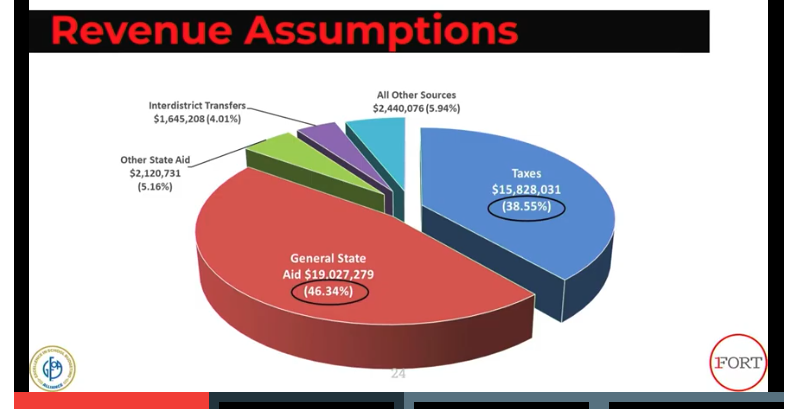
Demerath’s next slide (shown above) used a pie graph to show the breakdown of the district’s revenue sources.
Demerath said the chart showed that next year, state aid is projected to comprise 46% of revenue, with taxes comprising 38.5% of revenue.
“This is a result of the action taken as part of the state budget where a large increase in state aid was approved to meet federal requirements, but no corresponding increase in state allowable revenue was approved. Therefore, all of this new state aid simply goes to offset property taxes rather than being funding for the classroom,” Demerath said.

A second pie graph (shown above) Demerath said, illustrated the impact state budget decisions have on local revenues.
“We can see that all but 9.95% of our $41 million budget is dictated directly by the state through the revenue limit, state general aid, and state categorical aids. Of the remaining two slices shown here, interdistrict transfers is almost exclusively open enrollment revenue and the remainder of other sources are local fees and grants, which includes the one-time federal COVID relief funds,” he said.

Looking at expenditures, Demerath said, the major categories included salaries and wages, benefits, purchased services, non-capital and capital objects, insurance, inter-fund transfers, and other miscellaneous expenditures.
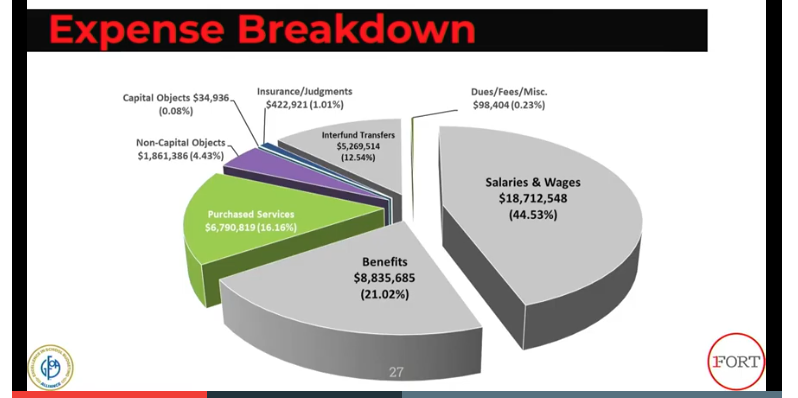
Said Demerath: “As a service business, about 78% of our budget is spent on personnel to provide the service of educating our community’s children. The next largest section of the budget is purchased services, which includes everything from transportation and utilities to substitute teachers and open enrollment payments to other districts.
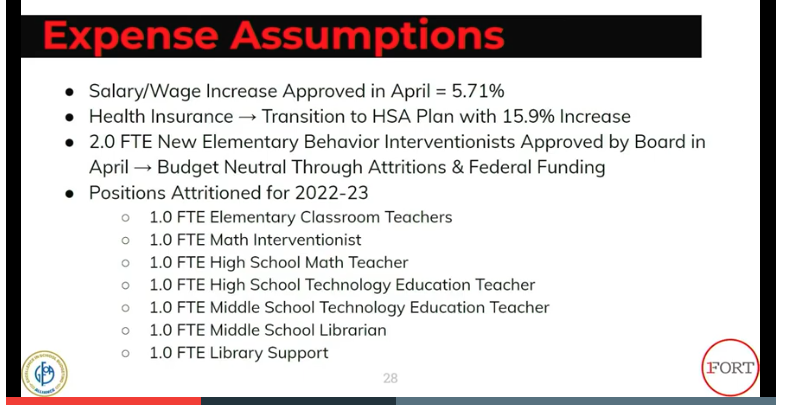
Looking at expense assumptions built into the proposed preliminary budget, Demerath said, “they largely coincide with the strategies I mentioned earlier that we were planning to leverage.
“The board approved a full CPI (Consumer Price Index) salary and wage increase, plus market adjustments, for our 1Fort team members in April. We also will be transitioning all active employees that take health insurance to the HSA plan in an effort to mitigate the large renewal increase without putting more costs for that plan on our employees and eating into that wage increase.”
In April, Demerath said, the board approved adding two new behavior interventionists at the elementary level.
He called the positions “budget neutral additions” because, he noted, “they will be paid for through federal funding and attrition of special education support positions.”
Further, he said: “You will also recall that one of the strategies we are leveraging is to evaluate all vacancies for possible attrition or restructuring along with prioritizing academic return on investment and recognizing opportunities for strategic abandonment. These strategies have been implemented since this winter, and will continue moving forward … While some of these positions are outright attritions due to matching student enrollment, some are also restructuring.”
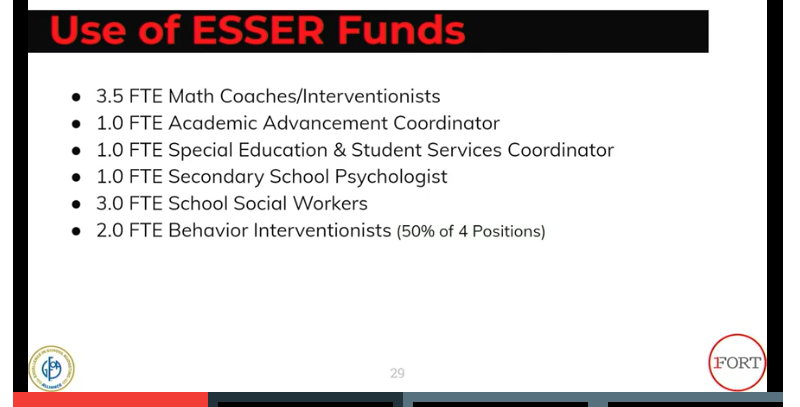
Additionally, Demerath said, a strategy implemented by the district in the current fiscal year is to use its one-time federal COVID relief funds, or ESSER funds, to offset operational deficits and provide mental health services and supports.
“The use of these funds in this way aligns directly with what the community shared they would like us to use these funds for as part of our survey earlier this year,” Demerath said.
Referencing a slide (shown above) he said the district has 11.5 total certified positions that are being funded by federal funds next year which helps to manage operational costs.
“(It’s) something we will need to reevaluate as this one-time federal funding ends in a couple of years,” he said.
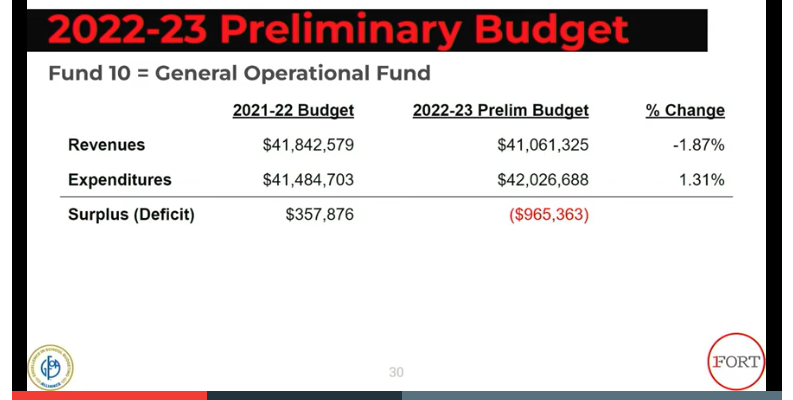
Presenting a Fund 10 comparison (shown above) between the 2021-22 operating budget and the 2022-23 proposed preliminary budget, Demerath said the current year’s budget showed a surplus of $357,000 after the district moved some current year expenses onto federal COVID relief funds.
“In looking at next year, we are currently budgeting for a deficit of just under $1 million, which was planned, as we will be entering the third year of our operational referendum … we were projecting a deficit of almost $1.3 million a couple of years ago even with revenue increases,” Demerath noted.
Further, he said, “due to declining enrollment, our revenue decreases by 1.87% while our expenses increase by only 1.31%. Again, a reminder that the 1.31% increase includes a 5.71% wage and salary increase so our team members can keep up with the inflationary environment we are all experiencing.”
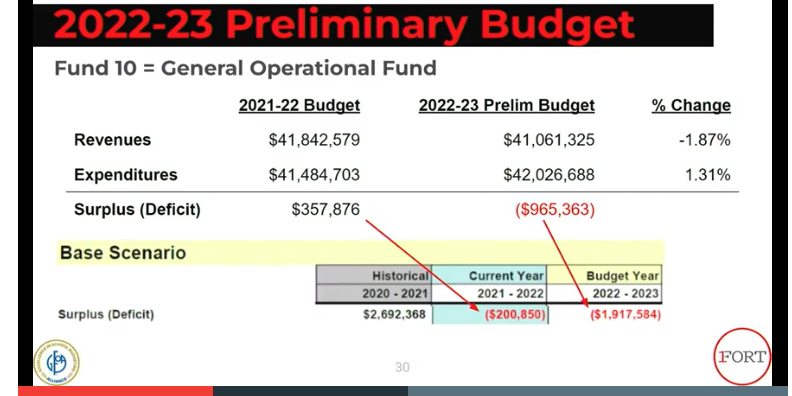
Demerath continued: “If we think back to January and February, when we were first learning about the large inflationary impact and health insurance increases, the projection at that time had our deficit at almost $2 million. The strategies that we have implemented over the past few months have dropped that projected deficit by $1 million, all while taking care of our team members.”
He offered praise to the “1Fort team across the district in making this happen as they worked to restructure and attrition positions to leverage these strategies, all while working to improve the education we provide and student outcomes to meet our strategic goals.”

Demerath next produced a slide (shown above) which examined the preliminary tax levy projection. Looking at the first line of the chart, he said, the district is projecting a tax levy in the general fund that is about $2 million less than 2021-22.
“That $2 million is a result of about an $800,000 decrease due to enrollment and about $1.2 million in new state aid without a revenue limit increase. This is one of the factors that allows for a possible referendum in November with a minimal tax rate increase. The other major factor that is part of the referendum planning is that our referendum approved debt will be completely paid off next year, which is why the tax levy for referendum debt all but disappears.
“We go from a tax levy for this debt of $1.4 million all the way down to $50,000. All of this results in a total tax levy of $16 million dollars, $3.5 million less than last year, which translates to a projected tax rate of $8.72, a 20% decrease from the current year. All of this has been part of our referendum planning,” he said.
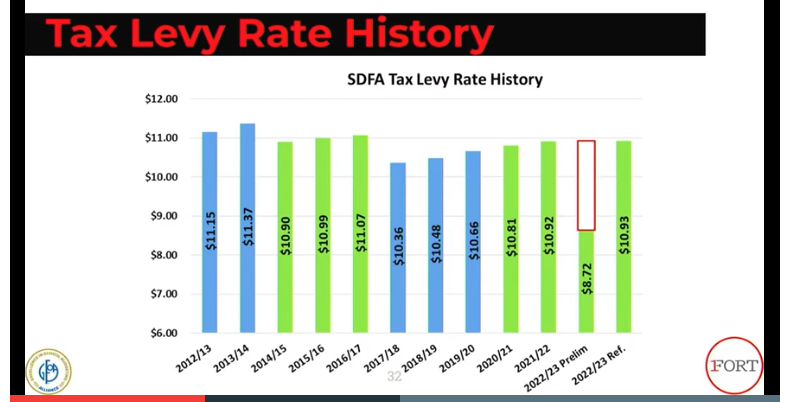
Producing a bar graph (shown above) showing a 10-year history of the district’s tax levy rates, Demerath said: “we can see each of our recent three year operational referenda shown here in alternating colors of blue and green.
“This coming year’s projected tax rate of $8.72 is well below where we have been over the past decade or more due to the increase in state aid without a corresponding revenue limit increase, and the retirement of our debt. This drop is what creates the room for a referendum with minimal impact to the tax rate.”

Looking at a history of the state’s private school voucher program and its impact on the district’s levy rate, Demerath said: “The cost of those private school vouchers used in a local school district by community members is passed through the local school district’s tax levy, resulting in increased local taxes beyond the taxes used by the public school. Pointing to a slide (shown above), he said the orange portion of the bars in the graph show the impact made by private school vouchers on the local tax rate.
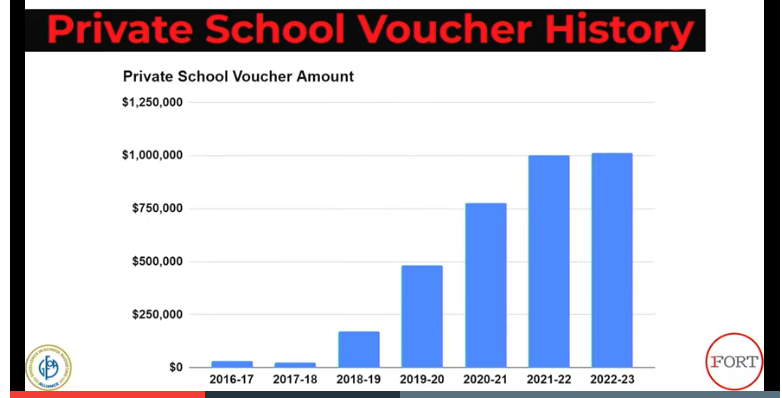
Another slide presented by Demerath (shown above), indicated the increase in private school vouchers over the past six years.
Said Demerath: “At this time, we are projecting no increase for next year as we get no data whatsoever from the state about vouchers other than what to put on the property taxes. Therefore, we have no way of knowing what to project for next year. Should there be an increase in private school vouchers next year, there would be a corresponding increase in taxes to pay for those vouchers.”
Demerath said the increase in voucher expenses was not an indication that students were leaving the district to attend private schools.
“While there may be a few that do, the increase here is related to more families becoming eligible for and taking advantage of the state private school voucher program, even if they attended those private schools without vouchers in the past or never attended our public schools,” he said.
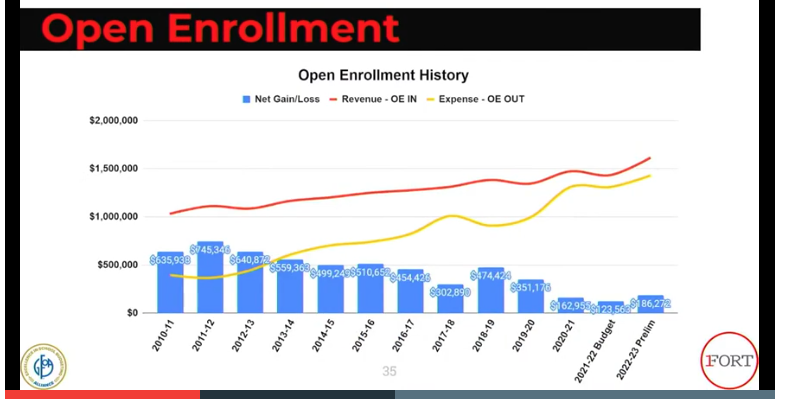
Demerath also shared a slide (shown above) depicting trends in open enrollment.
He said the gap between the number of students leaving the district, compared to those coming into our district, has closed in recent years.
“However, for next year, we are projecting that gap may widen just a bit,” he said.
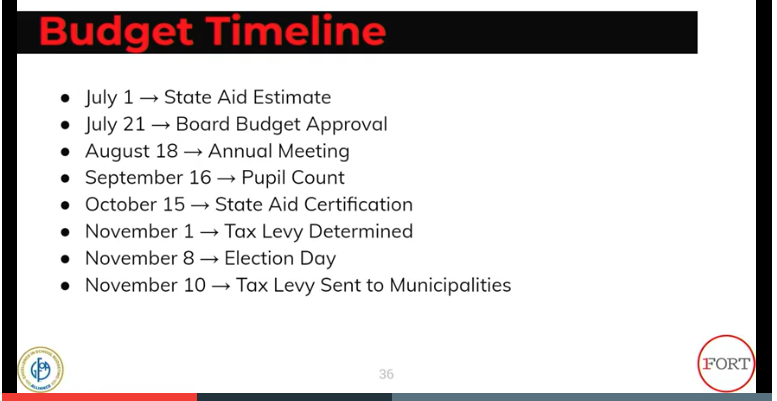
Demerath concluded his first presentation with a timeline of upcoming events pertaining to the creation of the 2022-23 final school district budget.
Capital improvements presentation
Aided by slides, Demerath’s second presentation shared a proposal for crafting a capital improvements referendum question for placement on the November ballot. The following information was presented.
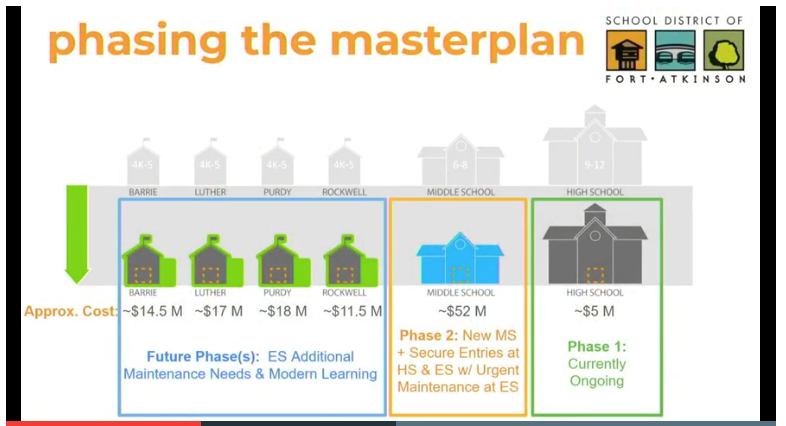
Looking at a capital improvements referendum, Demerath said in October, the district proposed it would create three phases to its master long-range facilities plan.
Said Demerath: “The first phase was the work that is currently underway at the high school related to mechanical issues and energy efficiency upgrades to replace some failing systems in that building.
“The second phase is what we have been investigating and gathering feedback on, which was related to a possible new middle school, secure entries at the rest of our buildings, and urgent maintenance at the four elementary schools.”
A third phase was proposed as part of future planning and revolved around addressing long-term maintenance needs and modernizing learning environments within the district’s elementary schools, he said.
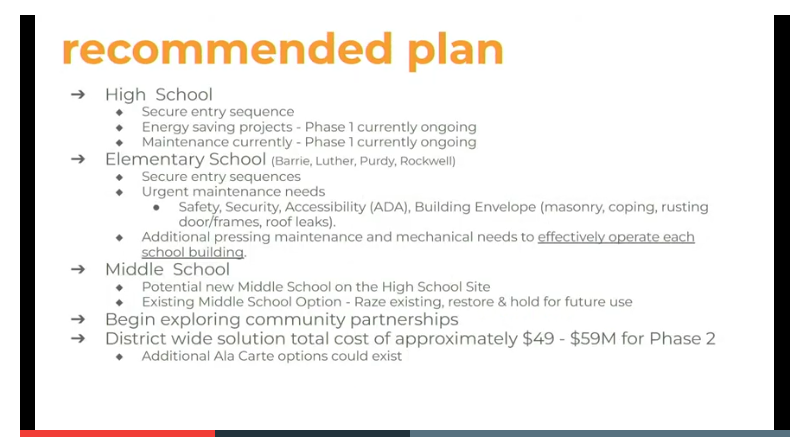
Providing a recap of the phase two plan, Demerath said the district had been investigating throughout the year making improvements within its buildings.
At the High School, he said, the plan proposed creating a secure entry sequence and a continuation of the projects that were ongoing.
At the four elementary schools, he said, the district was looking at creating secure entry sequences, and performing urgent maintenance needs and additional pressing maintenance and mechanical needs to effectively operate each school building until phase three could be determined.
At the middle school, he said, the district was looking at the potential for a replacement building at the high school site and options for what to do with the existing building.
“Overall, phase two was estimated to be in the $49 million to $59 million range last fall when it was shared out.
“As we all know, since last October a lot has changed. Along with everything we learned during our engagement with the community, there have been national economic challenges related to inflation and future economic uncertainty, and there has also been a city referendum that was passed that influenced things locally. As a result, we are going to recommend a modified long-range capital plan that we believe listens to the concerns of our community stakeholders,” Demerath said.
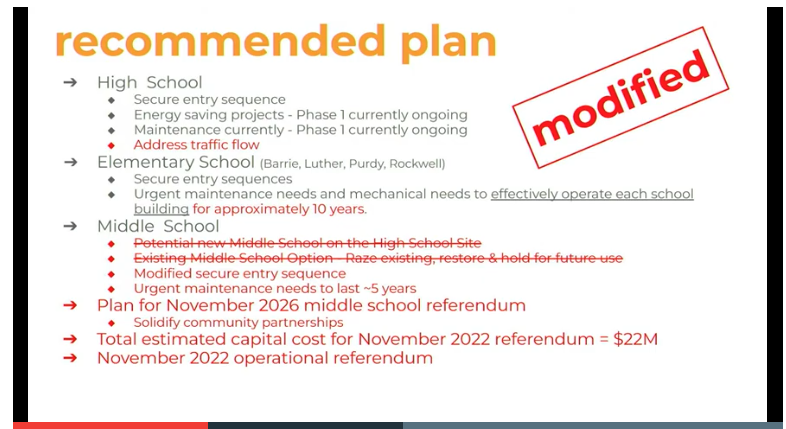
Demerath described the “modified” plan proposed by the district as “essentially a further phasing of phase two of the long-range master plan.”
Modified recommendations include: a secure entry sequence and continued work that has been ongoing at the high school.
“We also believe we need to address the traffic flow (at the high school) in the next year or so. Traffic flow was a major concern we heard from the community this year and with the new neighborhood development (on Banker Road) starting sometime in 2023, we have the opportunity to adjust traffic flow on our high school campus as that neighborhood comes online and is connected to our property,” Demerath said.
At the elementary schools, he said, secure entry sequences would remain part of the modified plan, along with maintenance and mechanical needs within elementary school buildings, which would be anticipated to last for approximately ten more years, at which time phase three of the master plan could be enacted.
“It is important to note that this will not change the educational layout, classrooms or environment; rather it would address what is necessary to effectively operate the school as is for the next ten years or so,” Demerath said.
The largest modification to the plan was at the middle school, he said, adding: “While we acknowledge that there is part of our community that would like us to move ahead with building a new middle school at the high school site this year, in our year-long conversation with the larger community, it has become apparent that the time for this might not be right and that our operational needs are of highest priority right now. As a result, we are recommending not to ask the community to support a new middle school at this time.”
Instead, he said, plans call for a secure entry sequence at the current middle school and the district would address urgent maintenance needs at that building so that it can function for the next five years.
“We would only put dollars that are absolutely necessary to make that happen into the current building as we would transparently share with the community that we will be back in November, 2026, to ask for that new middle school building. Along the way we would look to solidify community partnerships around that new building,” Demerath said.
The total estimated cost of of the modified plan is $22 million, he said.
A referendum question, asking the voters to fund that amount, is planned for placement on the November ballot.
“Alongside that capital referendum this fall would be an operational referendum to meet our operational needs for the next four years,” Demerath said.
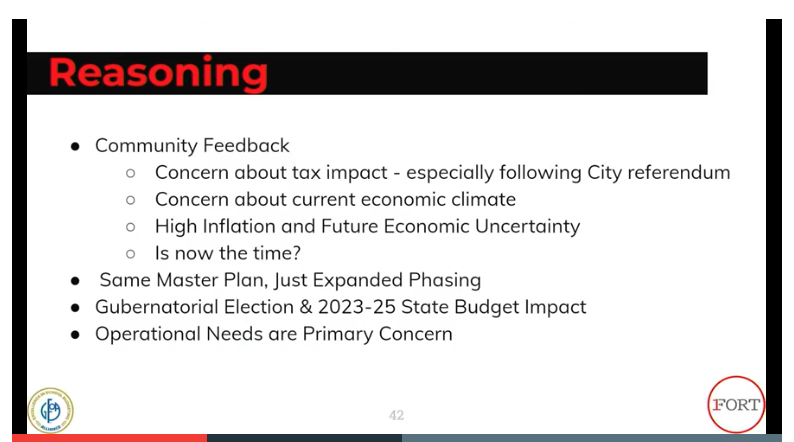
Presenting a slide titled “Reasoning,” Demerath said the modified capital improvements plan came as a result of listening to the community and feedback received over the course of this school year.
Two community surveys and several engagement sessions were among sources of the feedback, he said.
Changes in the economic climate at the national, state and local levels were cited by Demerath as among drivers of the objections to the original plan, which was presented last October.
“Between inflationary pressures and the referendum that was passed by the city in April, it has become a question as to whether this is the best time to be asking for a new school. With no immediate end in sight for these inflationary pressures or the economic uncertainty, we feel it may be best to address our community’s concern by further phasing these projects and putting the Middle School off until things settle down a bit more with these issues,” Demerath said.
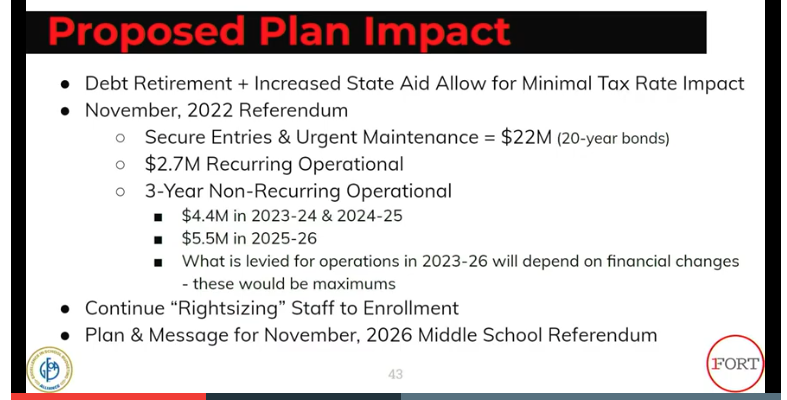
Returning to the subject of tax rates and operational referendums, Demerath said: “As a result of a full retirement of all referendum debt plus a large increase in state aid without a corresponding revenue limit increase, there is room for both an operational and capital referendum this fall with minimal impact to the tax rate. What we are proposing is a $22 million capital referendum funded through 20-year bonds that would put secure entries in all six buildings, address urgent maintenance needs at all six buildings, and address traffic flow issues at the high school as the neighborhood gets developed.”
He continued: “On the operational side, we are currently estimating that with the $22 million dollar capital referendum and targeting the current tax rate we could get through 2025-26 with a $2.7 million recurring referendum, a $4.4 million dollar non-recurring referendum in 2023-24 and 2024-25, and a $5.5 million dollar non-recurring referendum in 2025-26.
“I will put a caveat with all of these numbers that these are projections right now, and we will get even better information in July when we get our state aid estimate, so these numbers may change a bit before final approval. I will also note that these dollar amounts would allow us to get through 2025-26 and would be the maximum amount we would levy in these years. Should financial circumstances change and not all of these funds are needed, the board could consider not to tax for the full amount of these referendums based on the financial circumstances at the time.”
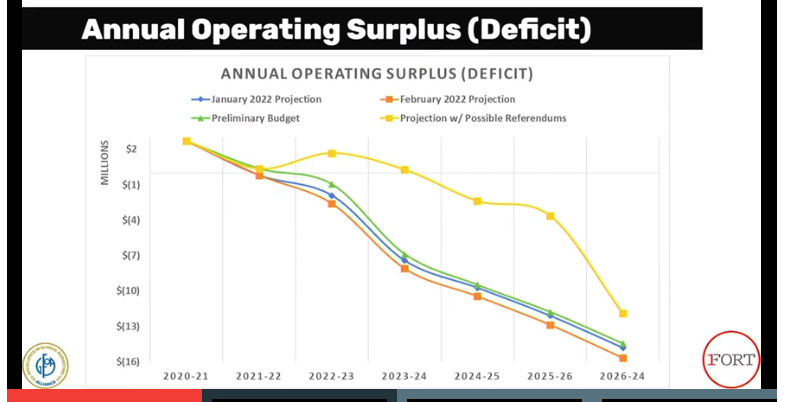
In conclusion, Demerath presented a graph showing annual operating expanses as anticipated by the district between school years 2020-21 and 2026-27.
Pointing to the graph (shown above), He said: “The blue line is where we started our work this year in January with what was projected for our long-range financial situation.
“In February, we received news of inflation and the CPI increase along with our health insurance increase, which resulted in the situation getting worse, as represented by the orange line.
“Since February, we implemented the strategies I mentioned earlier this evening to not only get back to where we started, but to move all the way to the green line and have a budgeted surplus in the current year and trimmed a million dollars off of next year’s deficit.”
Would the referendum question as presented come before the voters in November and garner approval, he said, the result would be indicated by the yellow line, giving the district the ability to provide services through 2025-26 with what Demerath described as “a minimal tax rate impact.”
Questions from the board
Responding to questions asked by board member Chris Rogers, Demerath said that would the proposed referendum fail, next year, the district would have a million dollar deficit.
“It would be the following year where it would be upwards of $3 to $4 million,” he said.
That would be funded through reductions or through a possible spring of 2023 operational referendum, he added.
Board members asked for clarification that the district would be bringing two referendum questions before the voters in November.
Demerath said they would, one question asking for operational dollars, and a second asking for capital improvement dollars.
Demerath noted that school districts are restricted by the state as to the number of referendum questions they can bring before voters each calendar year. They can bring only two, he said.
If two questions failed in November, he said, the district could come back in the spring with a question or two. That would be it for 2023, he said.
Further, he said, questions can only be included on ballots for general election dates.
In past years, districts could hold their own elections to bring referendum questions before voters, he said, adding that the rules have since been changed. Districts must now place their questions on existing general election ballots.
Referencing the modified proposal, Board of Eduction President Kory Knickrehm said: “I think this makes a lot of sense. We learned from the survey that maybe things that I didn’t really consider previously (are) important … traffic flow, and things like that … I think we are being extremely fiscally responsible with what we are doing here, and continue to right-size some staffing, and things like that. This makes a whole lot of sense to me.”
He was in support of gathering information and moving forward with the plan as presented, he said.
Relative to building a new middle school potentially in 2026, Board of Eduction member Robynn Selle asked about risk. She cited the possibility of a new board and school administration in the future, and choices they might make. She described the middle school as being “in a pretty precarious position.”
Said Demerath: “I think there is always a risk when looking beyond the current year. (School year) 23-24 would be the next year of the next (state) biannual budget, and we have no clue of what could be coming in the next state budget, but along the same lines, if we have a long-ranged year-plus master facilities plan along the way, that’s what we work towards, and plan a few years out at a time.”
If circumstances change, he said, the district would continue to adapt and change.
Referencing the timeline for the next proposed possible referendum that might include a new middle school, in 2026, he said, among factors is the new neighborhood being developed next to the high school.
“It would be two to three years old, and people would be able to see the development happening, and will know, enrollment-wise, what might be coming as well.”
Selle said she thought the proposed approach made sense.
Defining the concept of “right-sizing” staff, School District of Fort Atkinson Superintendent Rob Abbott said: “When we have openings, there isn’t a posting that follows five minutes later, but, instead, there is a legitimate study of … the program, the viability, (asking) are there some opportunities to use that position differently? Or use that staffing differently? Or to use different staff for that type of programming? What does the enrollment look like presently? And then, moving forward, are there efficiencies for us? Especially with four elementary schools, are there some things that we can do between schools or by moving things from one place to another, or moving staff from one place to another? So, in the list that Mr. Demerath shared earlier, I can guarantee you that we’re … data-gathering and (there is ) conversation and discussion around the pros, cons the impacts … down the road with or without those positions.”
Abbott said, with the proposed budget, there were not layoffs and the district was still able to make the reduction of “just around a million dollars.”
Abbott said area public schools are seeing declining enrollment.
“Districts are looking to find if and where there is a plateau. With fewer numbers, comes some tough things that we need to talk about, like what is a class size that’s too small? What is a class size that’s too big? Do you have everything at all of the levels in all of your schools?” he said.
Board of Education member Amy Reynolds said she appreciated that the district could change.
“We’re not stuck doing something. Change can be a good thing,” she said.
Demerath said next steps in the referendum process involve the further development of the phased plan as proposed with more detail to be presented again in July.
Demerath noted that a motion was not required, but staff was looking for conversation and a general direction from the board in terms of how it would like to move forward.
The board agreed staff should continue development of the proposed plan.
This post has already been read 1997 times!